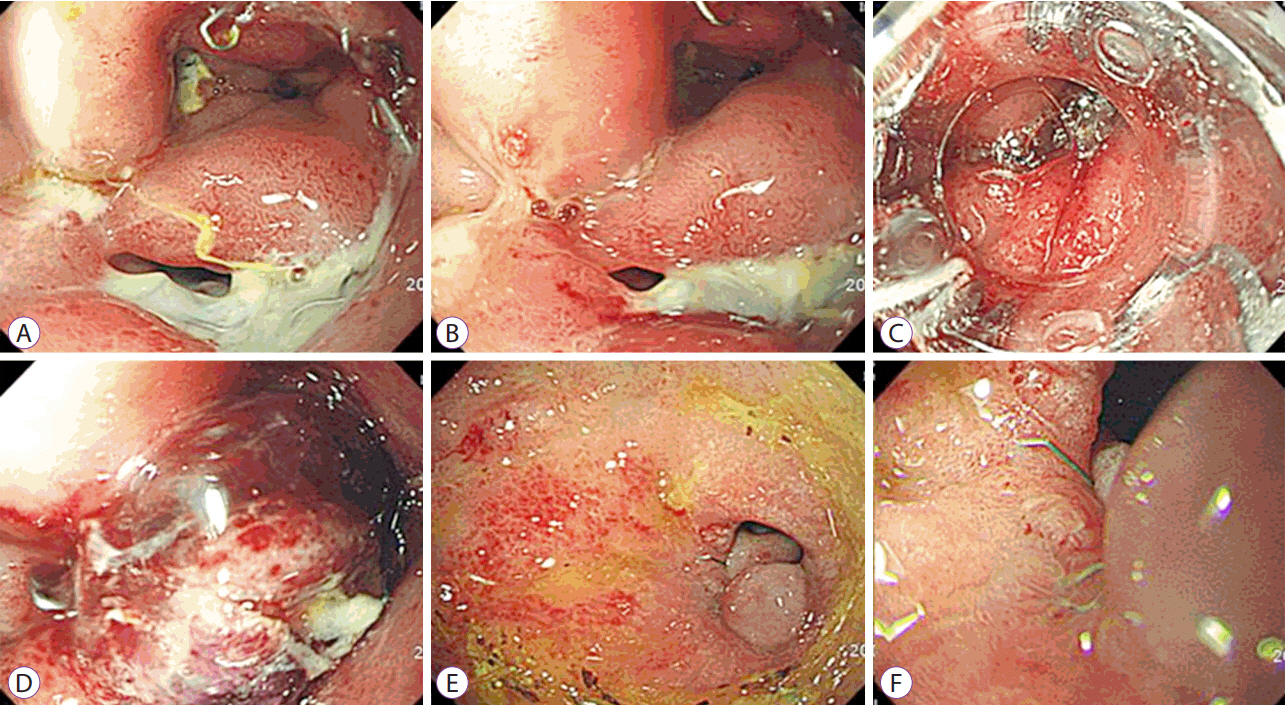Clin Endosc.
2018 Jan;51(1):61-65. 10.5946/ce.2017.027.
Efficacy of the Over-the-Scope Clip System for Treatment of Gastrointestinal Fistulas, Leaks, and Perforations: A Korean Multi-Center Study
- Affiliations
-
- 1Department of Internal Medicine, Hanyang University College of Medicine, Seoul, Korea.
- 2Digestive Disease Center, CHA Bundang Medical Center, CHA University, Seongnam, Korea.
- 3Digestive Disease Center, Soonchunhyang University Hospital, Seoul, Korea. cjy6695@cha.ac.kr
- 4Department of Internal Medicine, Korea University College of Medicine, Seoul, Korea.
- 5Center for Gastric Cancer, Research Institute and Hospital, National Cancer Center, Goyang, Korea.
- 6Department of Gastroenterology, Eulji University School of Medicine, Eulji Hospital, Seoul, Korea.
- 7Department of Internal Medicine, Chungbuk National University Hospital, Chungbuk National University College of Medicine, Cheongju, Korea.
- KMID: 2403634
- DOI: http://doi.org/10.5946/ce.2017.027
Abstract
- BACKGROUND/AIMS
Currently, a new over-the-scope clip (OTSC) system has been introduced. This system has been used for gastrointestinal perforations and fistulas in other countries. The aim of our study is to examine the therapeutic success rate of endoscopic treatment using the OTSC system in Korea.
METHODS
This was a multicenter prospective study. A total of seven endoscopists at seven centers performed this procedure.
RESULTS
A total of 19 patients were included, with gastrointestinal leakages from anastomosis sites, fistulas, or esophageal perforations due to Boerhaave's syndrome. Among these, there were three gastrojejunostomy sites, three esophagojejunostomy sites, four esophagogastrostomy sites, one esophagocolonostomy site, one jejuno-jejunal site, two endoscopic full thickness resection site closures, one Boerhaave's syndrome, two esophago-bronchial fistulas, one gastrocolonic fistula, and one colonopseudocyst fistula. The size of the leakage ranged from 5 to 30 mm. The median procedure time was 16 min. All cases were technically successful. Complete closure of the leak was achieved in 14 of 19 patients using OTSC alone.
CONCLUSIONS
The OTSC system is a safe and effective method for the management of gastrointestinal leakage, especially in cases of anastomotic leakage after surgery.
MeSH Terms
Figure
Cited by 2 articles
-
Editors' Choice of Noteworthy Clinical Endoscopy Publications in the First Decade
Gwang Ha Kim, Kwang An Kwon, Do Hyun Park, Jimin Han
Clin Endosc. 2021;54(5):633-640. doi: 10.5946/ce.2021.216.Successful Closure of a Benign Refractory Tracheoesophageal Fistula Using an Over-the-Scope Clip after Failed Esophageal Stent Placement and Surgical Management
Nonthalee Pausawasdi, Chotirot Angkurawaranon, Tanyaporn Chantarojanasiri, Arunchai Chang, Wanchai Wongkornrat, Somchai Leelakusolvong, Asada Methasate
Clin Endosc. 2020;53(3):361-365. doi: 10.5946/ce.2019.106.
Reference
-
1. Parodi A, Repici A, Pedroni A, Blanchi S, Conio M. Endoscopic management of GI perforations with a new over-the-scope clip device (with videos). Gastrointest Endosc. 2010; 72:881–886.
Article2. Yoon JH, Lee HL, Lee OY, et al. Endoscopic treatment of recurrent congenital tracheoesophageal fistula with histoacryl glue via the esophagus. Gastrointest Endosc. 2009; 69:1394–1396.
Article3. Lopes MF, Catré D, Reis A, Leitão LM. Endoscopic treatment of recurrent tracheoesophageal fistula with histoacryl glue. Gastrointest Endosc. 2010; 72:1324–1325. author reply 1325.
Article4. Park SW, Lee HL, Ahn SE, et al. A case of successful endoscopic management of afferent loop leakages by using hemoclips and a detachable snare. Korean J Gastrointest Endosc. 2008; 37:30–34.5. Haito-Chavez Y, Law JK, Kratt T, et al. International multicenter expe- rience with an over-the-scope clipping device for endoscopic management of GI defects (with video). Gastrointest Endosc. 2014; 80:610–622.6. Caulfield H, Hyman NH. Anastomotic leak after low anterior resection: a spectrum of clinical entities. JAMA Surg. 2013; 148:177–182.7. Metcalf C. Enterocutaneous fistulae. J Wound Care. 1999; 8:141–142.
Article8. van Boeckel PG, Dua KS, Weusten BL, et al. Fully covered self-expandable metal stents (SEMS), partially covered SEMS and self-expandable plastic stents for the treatment of benign esophageal ruptures and anastomotic leaks. BMC Gastroenterol. 2012; 12:19.
Article9. Kim JS, Kim BW, Kim JI, et al. Endoscopic clip closure versus surgery for the treatment of iatrogenic colon perforations developed during diagnostic colonoscopy: a review of 115,285 patients. Surg Endosc. 2013; 27:501–504.
Article10. Haider S, Kahaleh M. The use of endoscopic clipping devices in the treatment of iatrogenic duodenal perforation. Gastroenterol Hepatol (NY). 2010; 6:660–661.11. Carrott PW Jr, Low DE. Advances in the management of esophageal perforation. Thorac Surg Clin. 2011; 21:541–555.
Article12. Blackmon SH, Santora R, Schwarz P, Barroso A, Dunkin BJ. Utility of removable esophageal covered self-expanding metal stents for leak and fistula management. Ann Thorac Surg. 2010; 89:931–936. discussion 936-937.
Article13. Baron TH, Song LM, Ross A, Tokar JL, Irani S, Kozarek RA. Use of an over-the-scope clipping device: multicenter retrospective results of the first U.S. experience (with videos). Gastrointest Endosc. 2012; 76:202–208.
Article14. Arezzo A, Verra M, Reddavid R, Cravero F, Bonino MA, Morino M. Efficacy of the over-the-scope clip (OTSC) for treatment of colorectal postsurgical leaks and fistulas. Surg Endosc. 2012; 26:3330–3333.
Article15. Manta R, Manno M, Bertani H, et al. Endoscopic treatment of gastrointestinal fistulas using an over-the-scope clip (OTSC) device: case series from a tertiary referral center. Endoscopy. 2011; 43:545–548.
Article
- Full Text Links
- Actions
-
Cited
- CITED
-
- Close
- Share
- Similar articles
-
- Over-the-Scope Clip in the Treatment of Gastrointestinal Leaks and Perforations
- The use of OverStitchâ„¢ for the treatment of intestinal perforation, fistulas and leaks
- Endoscopic Management of Gastrointestinal Leaks and Bleeding with the Over-the-Scope Clip: A Prospective Study
- Endoscopic Treatment of Various Gastrointestinal Tract Defects with an Over-the-Scope Clip: Case Series from a Tertiary Referral Hospital
- Intestinal Perforation Caused by Lumboperitoneal Shunt Insertion Repaired with an Over-the-Scope Clip


